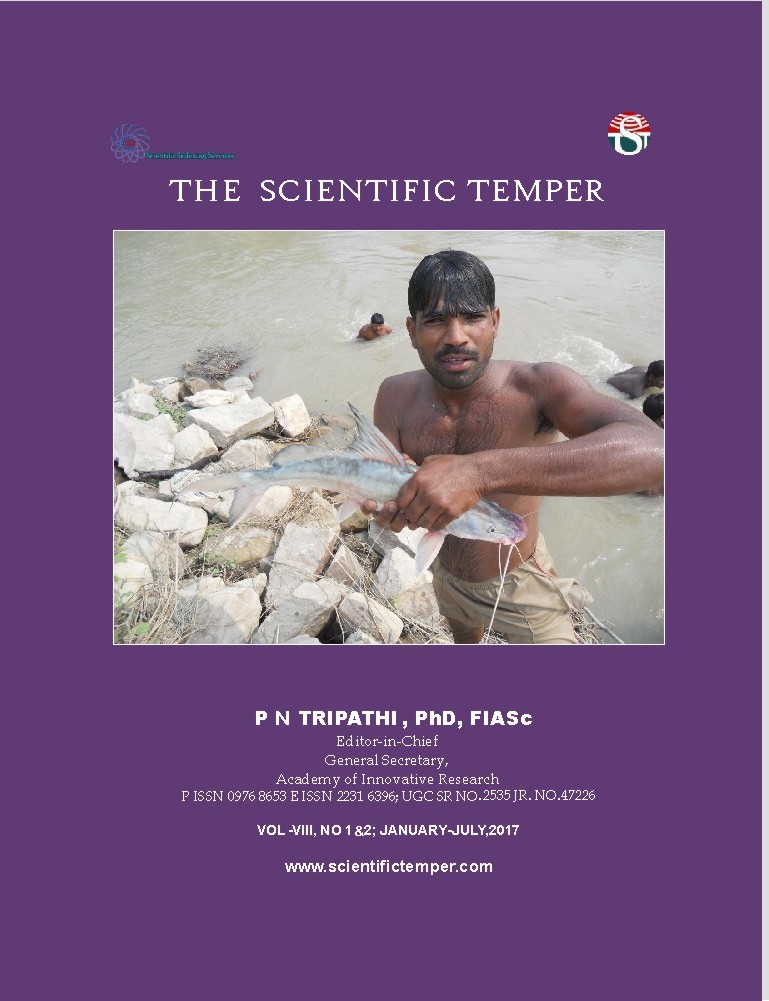ECOLOGICAL ENGINEERING OF MICROALGAE FOR ENHANCED ENERGY PRODUCTION
Downloads
Published
DOI:
https://doi.org/10.58414/SCIENTIFICTEMPER.2017.08.1.03Keywords:
Biomass, Chlorella vulgaris, Growth, Lipids, Microalgae, pH, Salinity.Dimensions Badge
Issue
Section
License
Copyright (c) 2017 The Scientific Temper

This work is licensed under a Creative Commons Attribution-NonCommercial-ShareAlike 4.0 International License.
Microalgae are considered as potential source of renewable energy generation. Algal biomass is used as key feedstock for renewable energy generation using algal resources. Accumulation of biomass mostly depends on the growth rate, which is usually regulated by pH and salinity. Present study was conducted to study the effect of variation in pH and saline rangeson growth, biomass and lipid content of a freshwater microalga Chlorella vulgaris. The growth, biomass and lipid content showed a significantAbstract
difference due to the variation in pH and saline range. The growth and lipid content was maximum at pH 7.0 with compared to 6, 8 and 9. On the other hand an increase of salinity from 0.1M to 0.25 M caused decreased growth rate, whereas the lipid content showed an increasing trend.
How to Cite
Downloads
Similar Articles
- Bayelign A. Zelalem, Ayalew Ali, BRICS and South African economic growth: Implications for Ethiopia, the new BRICS member , The Scientific Temper: Vol. 15 No. 04 (2024): The Scientific Temper
- RAMENDRA KUMAR DWIVEDI, PREM NARAYAN TRIPATHI, AGE AND GROWTH RELATIONSHIP OF CATLA CATLA IN AQUATIC ECOSYSTEM OF RIVER GHAGHRA AT AYODHYA , The Scientific Temper: Vol. 10 No. 1&2 (2019): The Scientific Temper
- Showkat Ahmad Shah, Netsanet Gizaw, Impact of selected macroeconomic variables on economic growth in Ethiopia: A time series analysis , The Scientific Temper: Vol. 14 No. 02 (2023): The Scientific Temper
- Chetna Dhull, Asha ., Impact of crop insurance and crop loans on agricultural growth in Haryana: A factor analysis approach , The Scientific Temper: Vol. 15 No. 01 (2024): The Scientific Temper
- Bratati Dey, Poonam Sharma, A comprehensive review of urban growth studies and predictions using the Sleuth model , The Scientific Temper: Vol. 15 No. 02 (2024): The Scientific Temper
- Teklu Hailu, Regasa Begna , Pre-extension demonstration of inter-cropping of improved forages with food and cash crops at Semen Bench Woreda, Southwest Ethiopia , The Scientific Temper: Vol. 15 No. 02 (2024): The Scientific Temper
- K.L Joshi, STUDIES ON PROGRESSION GROWTH FACTOR FOR ERI SILKMOTH, SAMIA RICINI DONOVAN (LEPIDOPTERA: SATURNIIDAE) , The Scientific Temper: Vol. 1 No. 01 (2010): The Scientific Temper
- Ramendra Kumar Dwivedi, Ved Prakash Tripathi, Nagendra Pratap Singh, P.N. Tripathi, Age and Growth Related Investigations on Major Carps in the Riverine Environment of River Ghaghra at and Around Faizabad , The Scientific Temper: Vol. 7 No. 1&2 (2016): THE SCIENTIFIC TEMPER
- Heena Gulia, Sunder Singh Arya, Neha Yadav, Ajay Kumar, Monika Janaagal, Mamta Sawariya, Naveen Kumar, Himanshu Mehra, Sunil Yadav, Sudershan Singh, Reetu Verma, Strategies for adaptations and mitigation of abiotic stresses in crops: A review , The Scientific Temper: Vol. 16 No. 01 (2025): The Scientific Temper
- Isreal Zewide, Tamiru Boni, Wondwosen Wondimu, Kibinesh Adimasu, Yield and economics of bean (Phaseolus vulgaris L.) as affected by blended NPS fertilizer rates and inter row spacing at maenitgoldia, Southwest Ethiopia , The Scientific Temper: Vol. 14 No. 02 (2023): The Scientific Temper
You may also start an advanced similarity search for this article.



